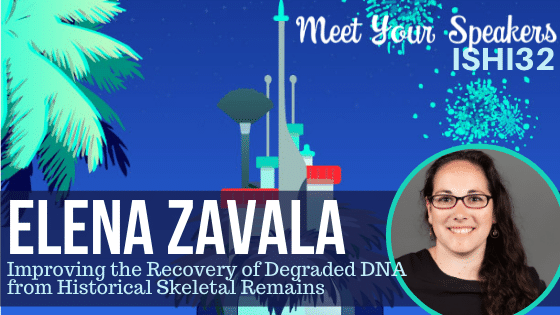DNA analysis has become an essential component for resolving unidentified human remains, disaster victim identification, and cold cases. Due to the high copy number of mitochondrial DNA (mtDNA) molecules in each cell compared to nuclear DNA, mtDNA is often used in these cases to aid with identification when nuclear DNA recovery fails. The Armed Forces Medical Examiner System’s Armed Forces DNA Identification Laboratory (AFMES-AFDIL) routinely works to identify individuals from highly degraded skeletal remains.
In her presentation at ISHI 32 this year, Elena Zavala, will be presenting on a study where three common forensic extraction methods were compared to one of the most widely used ancient DNA extraction methods using 15 skeletal remains with DNA of varying quality. She and her colleagues found that the ancient DNA extraction method recovered between 2 and 37 times as many DNA fragments that mapped to the human genome than any of the other extraction protocols.
We chatted with Elena to discuss challenges that arise when working with skeletal remains, how mitochondrial DNA analysis can assist with these challenges, and the oldest samples she’s worked with.
What are some of the challenges that come with working with historical skeletal remains or degraded remains?
There are several challenges that arise when working with these types of samples, most of which are related to the degraded nature of the DNA recovered from this material. This DNA can be too little or the fragments too short to serve as templates for typical forensic DNA typing methods. In addition, if the sample is contaminated with even a few cells of modern, pristine DNA it can cover up the authentic sequences we are trying to target.
How can mitochondrial DNA analysis or MPS/NGS technologies assist with these challenges?
The big advantage of MPS/NGS technologies is the ability to sequence many DNA fragments at the same time. This enables us to examine different types of variation within the human genome for identification purpose. It also allows us to use laboratory methods that are more sensitive and have been optimized to with highly fragmented and low input amounts of DNA. For very degraded samples, mitochondrial DNA is helpful as it is present in higher copy numbers within the cell (100-1000 copies per cell vs 2 copies for nuclear DNA). This means it is more abundant and therefore easier to recover from degraded samples. The downside of using mitochondrial DNA however is that it is not as discriminatory as nuclear DNA.
What three forensic methods did you examine in your study?
We examined different extraction methods and library preparation methods with the goal of identifying the best options for producing profiles from degraded skeletal samples using NGS.
What is the oldest bone or degraded sample that you’ve worked with and successfully developed a profile?
It depends on how you define a profile. Currently, I typically work with ancient DNA samples. I have recovered a full mitochondrial DNA genome from a sediment sample that was over 130,000 years old and nuclear DNA SNP profiles from skeletal material over 30,000 years old.
What tips would you give to someone who is just starting out in the field of forensics, or what is the best advice that you’ve received?
The best advice that I received when I first decided I wanted to study forensics over fifteen years ago was to first get a strong foundation in the natural sciences. As you begin to identify your area of interest I would recommend talking to as many people as possible who do what you want to do. This will help you learn how to follow their path and/or gain better insights into the reality of their job.
Has there been anything good that came out of the pandemic that you’ll continue doing going forward?
I hope to be better about balancing my time. I found that there are certain tasks and areas of work that are easier when working from home and others that are essential for in person. Hopefully I can maintain this balance in the future.
What is your favorite Disney character and why, or which Disney character do you most relate to and why?
My favorite Disney character has always been Pluto.
If you could have one superpower, what would it be and why?
Despite or perhaps because of my fear of heights, I would love to be able to fly.
What’s one thing that others may not know about you?
I also have a degree in music and play both the viola and piano.
WOULD YOU LIKE TO SEE MORE ARTICLES LIKE THIS? SUBSCRIBE TO THE ISHI BLOG BELOW!
SUBSCRIBE NOW!


